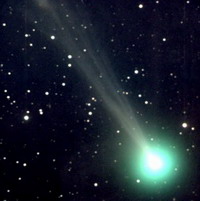Login form
Meteors
 Have you ever seen a shooting star? A bright light streaks across the sky. It looks like a star falling to Earth. It’s actually a meteor.
Have you ever seen a shooting star? A bright light streaks across the sky. It looks like a star falling to Earth. It’s actually a meteor.
UP IN SPACE
A shooting star is a piece of rock or metal. There are billions of chunks of rock and metal scattered throughout the solar system. Most are as small as grains of sand, but the largest are many miles across. A piece of rock and metal floating through space is called an asteroid.
FALLING
Sometimes asteroids come close to Earth. They fall through Earth’s atmosphere, the air around the planet. Earth’s atmosphere “rubs” against the rock. The rubbing makes the rock so hot that it glows. The glowing rock is called a meteor.
ON THE GROUND
Most meteors burn up before they hit the ground. All that’s left of them is specks of dust. Others are so big that they make it through the atmosphere and crash into Earth. A meteor that hits the ground is called a meteorite.
Meteorites can make big holes in the ground called craters. There are not many meteorite craters on Earth. Other planets, such as Mercury and Mars, have many more craters. Those planets don’t have thick atmospheres, so most meteors that fall toward them make it all the way to the ground. There are also lots of meteorite craters on our Moon and on the moons of other planets.
THREE NAMES FOR SPACE ROCKS
A space rock can be called by three different names, depending on where it is. The rock is an asteroid while drifting in space, a meteor when you see it burning through Earth’s atmosphere, and a meteorite after hitting the ground.
Source: Microsoft ® Encarta

